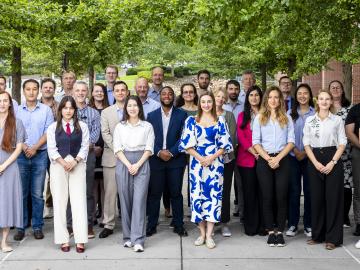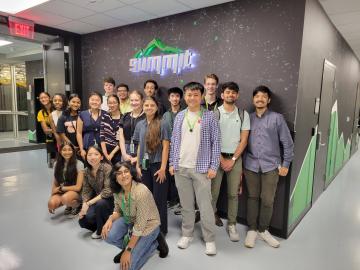
Filter News
Area of Research
- (-) Fusion and Fission (55)
- (-) Isotope Development and Production (3)
- (-) Supercomputing (313)
- Advanced Manufacturing (34)
- Biological Systems (18)
- Biology and Environment (178)
- Biology and Soft Matter (5)
- Building Technologies (12)
- Chemical and Engineering Materials (4)
- Chemistry and Physics at Interfaces (11)
- Clean Energy (525)
- Climate and Environmental Systems (14)
- Computational Biology (6)
- Computational Chemistry (5)
- Computational Engineering (5)
- Computer Science (19)
- Data (1)
- Earth Sciences (1)
- Electricity and Smart Grid (3)
- Energy Frontier Research Centers (14)
- Energy Sciences (5)
- Fossil Energy (3)
- Fuel Cycle Science and Technology (3)
- Functional Materials for Energy (16)
- Fusion Energy (19)
- Geographic Information Science and Technology (3)
- Isotopes (36)
- Materials (433)
- Materials Characterization (2)
- Materials for Computing (36)
- Materials Synthesis from Atoms to Systems (13)
- Materials Under Extremes (12)
- Mathematics (1)
- National Security (81)
- Neutron Data Analysis and Visualization (4)
- Neutron Science (191)
- Nuclear Science and Technology (74)
- Nuclear Systems Modeling, Simulation and Validation (3)
- Nuclear Systems Technology (1)
- Quantum Condensed Matter (4)
- Quantum information Science (9)
- Reactor Technology (1)
- Renewable Energy (4)
- Sensors and Controls (5)
- Transportation Systems (11)
News Type
News Topics
- 3-D Printing/Advanced Manufacturing (7)
- Advanced Reactors (7)
- Artificial Intelligence (36)
- Big Data (20)
- Bioenergy (10)
- Biology (12)
- Biomedical (18)
- Biotechnology (2)
- Buildings (5)
- Chemical Sciences (9)
- Climate Change (17)
- Composites (1)
- Computer Science (95)
- Coronavirus (14)
- Critical Materials (4)
- Cybersecurity (8)
- Decarbonization (7)
- Education (1)
- Energy Storage (11)
- Environment (22)
- Exascale Computing (25)
- Fossil Energy (1)
- Frontier (30)
- Fusion (23)
- Grid (7)
- High-Performance Computing (41)
- Irradiation (1)
- Isotopes (3)
- ITER (6)
- Machine Learning (14)
- Materials (16)
- Materials Science (20)
- Mathematics (1)
- Microscopy (8)
- Molten Salt (1)
- Nanotechnology (12)
- National Security (8)
- Net Zero (2)
- Neutron Science (14)
- Nuclear Energy (31)
- Partnerships (4)
- Physics (9)
- Polymers (2)
- Quantum Computing (19)
- Quantum Science (24)
- Security (5)
- Simulation (18)
- Software (1)
- Space Exploration (4)
- Summit (43)
- Sustainable Energy (13)
- Transportation (8)
Media Contacts

The Summit supercomputer, once the world’s most powerful, is set to be decommissioned by the end of 2024 to make way for the next-generation supercomputer. Over the summer, crews began dismantling Summit’s Alpine storage system, shredding over 40,000 hard drives with the help of ShredPro Secure, a local East Tennessee business. This partnership not only reduced costs and sped up the process but also established a more efficient and secure method for decommissioning large-scale computing systems in the future.

Three flights, five thousand miles and half a dozen clearances and permissions stood between Tetiana Maltseva and the Department of Energy’s Oak Ridge National Laboratory. When she finally arrived at the lab to represent Ukraine at the 2024 Nuclear Energy Management School, her vision was clear.

Nuclear physicists at the Department of Energy’s Oak Ridge National Laboratory recently used Frontier, the world’s most powerful supercomputer, to calculate the magnetic properties of calcium-48’s atomic nucleus.

Three staff members in ORNL’s Fusion and Fission Energy and Science Directorate have moved into newly established roles facilitating communication and program management with sponsors of the directorate’s Nuclear Energy and Fuel Cycle Division.

Two fusion energy leaders have joined ORNL in the Fusion and Fission Energy and Science Directorate, or FFESD.


A team of computational scientists at ORNL has generated and released datasets of unprecedented scale that provide the ultraviolet visible spectral properties of over 10 million organic molecules.

Research performed by a team, including scientists from ORNL and Argonne National Laboratory, has resulted in a Best Paper Award at the 19th IEEE International Conference on eScience.

This summer, ORNL welcomed more than 500 students to campus through the lab’s range of internship programs, which are offered in areas such as biology, national security and computing.

ORNL is leading three research collaborations with fusion industry partners through the Innovation Network for FUSion Energy, or INFUSE, program that will focus on resolving technical challenges and developing innovative solutions to make practical fusion energy a reality.


